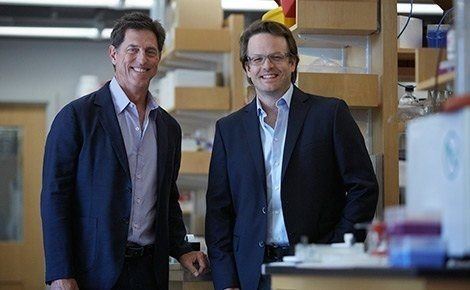September 22, 2015 — When Robert Farese and Tobias Walther were negotiating to join Harvard T.H. Chan School of Public Health last year as professors of genetics and complex diseases, they proposed a twist to their appointments—a joint laboratory run as an equal partnership. Although they were working in different institutions and came from different disciplines—Farese from physiology and biomedicine, Walther from cell biology and biochemistry —they had been collaborating remotely for a decade, finding fertile ground in their shared research interests, scientific values, and wide-ranging curiosity.
With research largely focused on how cells store and synthesize fat—a principle applicable to understanding obesity and its related diseases—they were keen to join a department well-known for its metabolism research. But their unusual lab arrangement might have been a hard sell in some quarters. Fortunately, Molecular Metabolism Chair Gökhan Hotamisligil got it, Farese said. “He was very enthusiastic.”
At the School, the two scientists have combined their areas of expertise to give the lab the capability to “bridge anything from physics to human genetics and everything in between,” Walther said. Both contribute ideas and act as each other’s sounding board. “If I can’t convince my best science friend that something is important and should be done, then there is a serious problem with it,” said Walther. “If we’re both excited about an idea, and we’re still excited a month later, it’s probably a better idea.”
Working together, they have identified more than 200 genes that regulate storage of lipids (fatty acids and oils that store energy and provide materials needed to build and maintain cell membranes). Lipids are stored in organelles known as droplets that play an important role in metabolic function. Walther and Farese have published a growing body of work unravelling the complex biology of lipid droplets, including a paper published August 10, 2015 in Developmental Cell, which explains a principle behind the composition of proteins on the surface of the organelles.
Their efforts received a significant endorsement in May when Walther was named a Howard Hughes Medical Institute Investigator. The prestigious five-year appointment provides each investigator with his or her full salary, benefits, and a research budget. Although the award is in his name, Walther is quick to include Farese in the honor.
A fruitful meeting
Their collaboration goes back to 2005 when Farese, then a professor of medicine, and biochemistry and biophysics at the Gladstone Institutes at the University of California, San Francisco (UCSF), decided to take a sabbatical year in his colleague Peter Walter’s lab to learn about cell biology. “I wanted to learn about how to think about problems differently,” Farese said. “I got really lucky because I sat down next to Tobi.”
Walther, then a postdoctoral researcher, was equally inspired by Farese. “I was on the trajectory of being a biochemist and cell biologist,” he said. “Then this sabbatical professor showed up who came from a different discipline and started talking about all these problems that had a strong overlap with my interests.”
Ten years later, they both agree that the collaboration has likely changed how they approach their research and what they produce. “It would be like if he wrote a song and I wrote a song and then we wrote one together,” said Farese. “All three would be completely different.”
Among the shared scientific values that bring them together is an emphasis on working towards a legacy focused on training the next generation of researchers and translating scientific contributions into clinical practice and public health.
Walther said, “We want to explain fundamental mechanisms and how they impact human health and disease. We’re not satisfied with scratching on the surface, and we will challenge each other and our lab members on clarity. I think we both have a pretty high allergy against intellectual mud.”
In addition to their work on metabolism research, Walther and Farese are working on understanding the mechanisms underlying neurological and neurodegenerative diseases. When asked where they hope to be in five years, Walther leaves the door open for the serendipity of discovery.
“The world is full of wonders,” Walther said, quoting Walter. “Every time you turn over a stone, there is something amazing lurking under it.”
Photo: Kent Dayton
